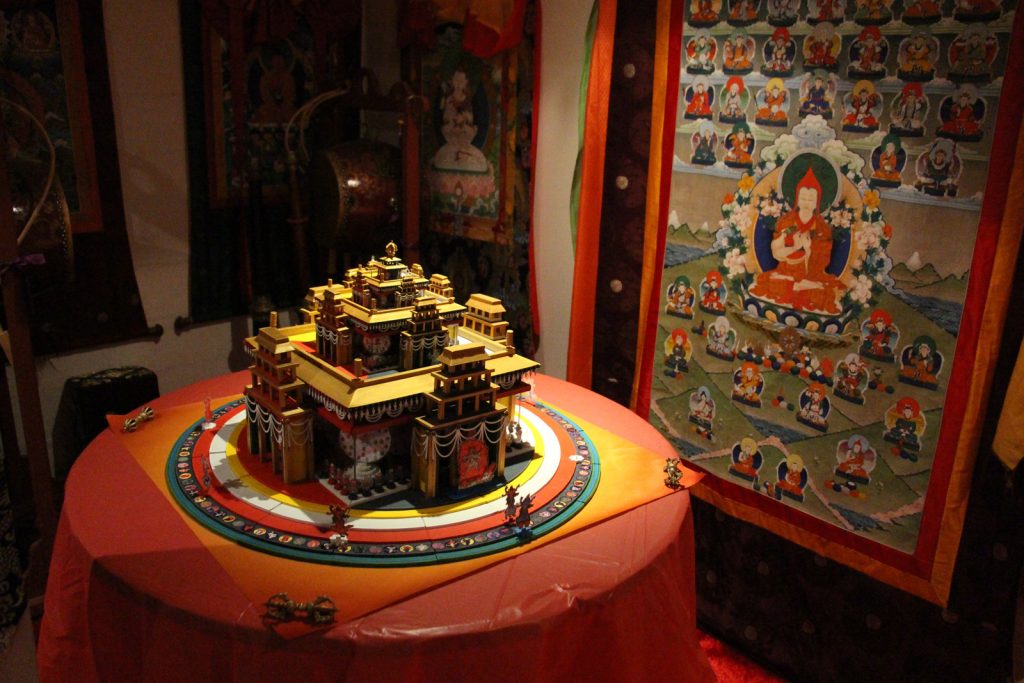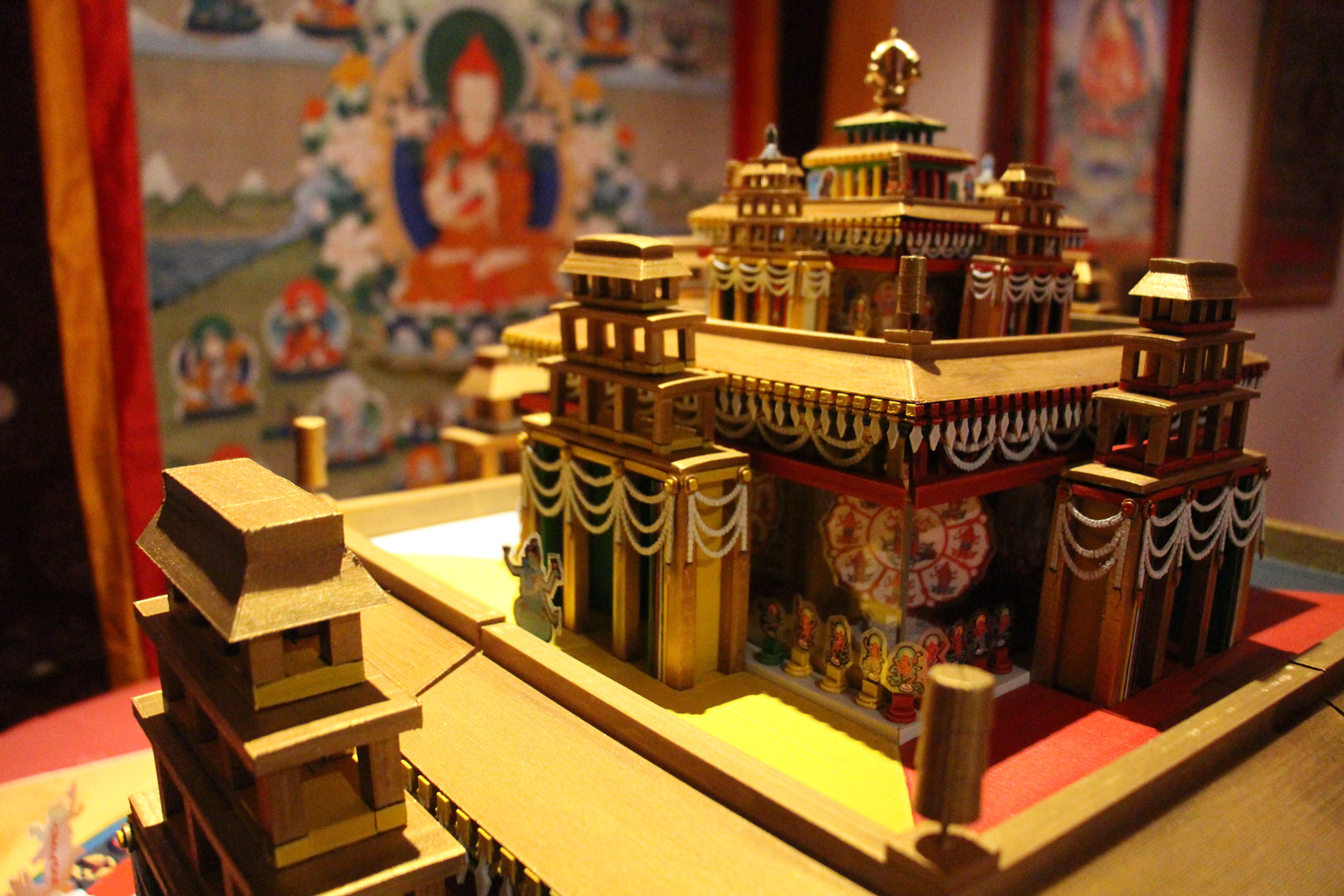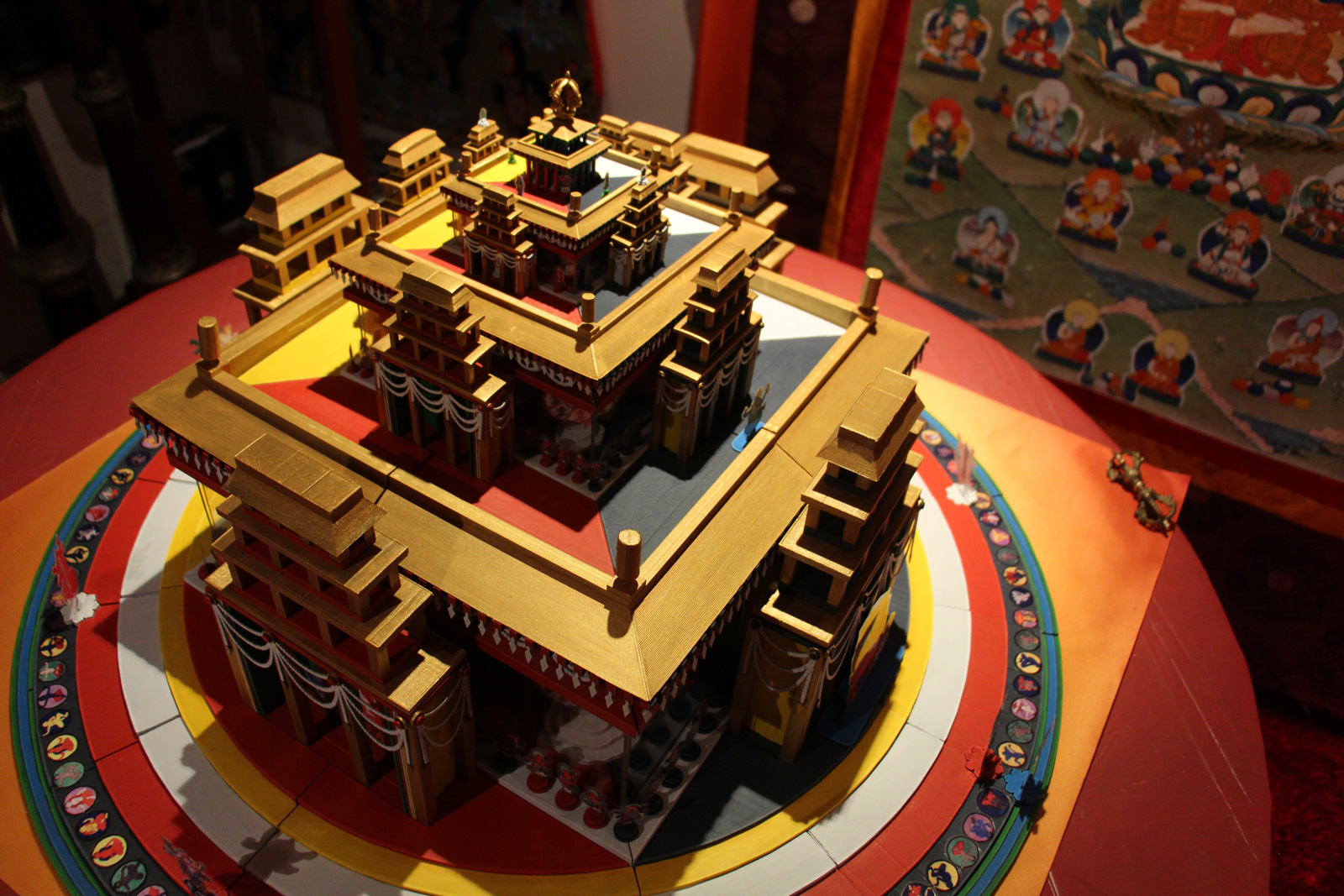For centuries, Vajrayana Buddhist masters have transmitted the practice of manifesting the Kalachakra, or Wheel of Time, mandala, an intricate visualization that is said to represent all of reality. Recently, Khentrul Rinpoche, a master in the nonsectarian rimé tradition known for his teachings on the Kalachakra system of the Jonang school, has come up with a new way of conjuring up this rich imagery—by 3D printing it.
But don’t be mistaken: this plastic model is far more than a cheap knockoff. It is packed with traditional details and symbolism in order to give people a deeper understanding of the complex teaching.
Kalachakra students are supposed to learn to visualize the mandala as a temple-like structure built of elemental materials. It houses 636 deities, each with unique features (a certain number of eyes, arms, ritual items, and so forth) and each symbolizing an aspect of reality. In the mandala visualization, practitioners come to regard the entire system as interdependent and nondualistic. But while teaching around the world, Khentrul Rinpoche found to his surprise that many people who were familiar with the Kalachakra mandala through sand mandalas or thangkas (scroll paintings) did not know that those depictions were meant to represent a three-dimensional image.
“It’s like looking at the blueprints of a house, instead of the house,” explained Ven. Tenpa’i Gyaltsen, a student of Khentrul Rinpoche with whom he has co-authored seven books about the Kalachakra teachings. “A 2D mandala is beautiful to look at, but it’s really hard for beginners to get the full sense of the volume and the space from it. But the instant they see the 3D mandala, they get it, which is an amazing feat and very beneficial for our practitioners.”
Gyaltsen handled the technical end of the mandala’s construction. Before moving to his teacher’s Tibetan Buddhist Rimé Institute in Belgrave, Australia, Gyaltsen was a graphic designer in Vancouver, Canada, where his work included building models for 3D printing.
The model took nine months to produce, including three months of round-the-clock 3D printing. In March 2019, Gyaltsen had a finished product. The assembled mandala is around 34 inches in diameter and 16 inches high, and is made up of more than 700 pieces, which can fit inside a carry-on suitcase that weighs a total of 46 pounds.
The fact that the mandala can be broken down and reassembled is not just for convenient travel but a key component in empowerment rituals. At a typical ceremony, a senior student, assisted by other sangha members, assembles the components in a specific order over the course of two days. Drawing from the instructions for creating sand mandalas, the practitioner on the first day manifests the structure of the mandala from outside in, and on the second day fills in the 636 deities—represented by printed cards—from the inside out. Since it is three-dimensional, the mandala has to be built up layer by layer, and during each layer, the pieces are arranged in order of the six colors representing the six elements, from gross to subtle: earth, water, fire, wind, space, and consciousness.
Watch a time-lapse of the 3D Kalachakra mandala
At the end of the ceremony, the mandala is dissolved in reverse order. Unlike in the sand mandala ritual, the slate is not entirely wiped clean since the discrete components remain. So Khentrul Rinpoche and his students incorporated into the ceremony the use of water and sand, which they can later disperse to retain the teaching on impermanence.
The sangha has used the mandala in three ceremonies so far. It was first consecrated in June this year at Tashi Chöthang Monastery, the home of Khentrul Rinpoche’s root teacher, Kyabje Lama Lobsang Trinley, in the Zidka region of Tibet. In August, they held a small ceremony at the Omega Institute in Rhinebeck, New York. And then in October, they performed an empowerment in Vienna with more 250 people in attendance from 21 different countries.
Throughout the design process, Gyaltsen frequently consulted with Khentrul Rinpoche and traditional source materials, such as the Kalachakra Tantra and various practice manuals developed by past Jonang masters.
“We value innovation . . . but believe it should be rooted in tradition,” said Gyaltsen. “Rinpoche always emphasizes the need to penetrate to the meaning of what is being expressed, what is symbolized and not the symbol. In order for these teachings to blossom in our cultures, we need to understand the deeper meaning and then manifest it in a natural expression. We can’t be just a bunch of foreigners replicating what other people do.”
That attention to the underlying meaning allowed for a necessary degree of flexibility. “Some details wouldn’t survive the 3D-printing process,” he explained. “We had to have a certain degree of blocky Lego-like quality to it. There are some limits to the technology, it’s not perfect.”
Three-dimensional mandalas are not new. They were often built as larger-scale permanent structures at Tibetan monasteries, especially in the Jonang tradition. What the 3D-printing technology makes possible for the first time is the ability to create cost-effective mandalas made up of component parts that students can handle individually and learn to construct. It also allows the model to be more portable and lets the design be shared digitally with anyone who has a 3D printer.
Gyaltsen said that the 3D mandala has already made a huge impact on students and monastics alike.
“In terms of the Western students . . . some people had taken empowerment 30 times with sand mandalas, and they never knew that the mandala was supposed to look like that,” he said. “For them to even think of it as a 3D form brings it to life. This is really inspiring for them.”
He said the Tibetan monastics at the first empowerment ceremony were impressed as well: “There was excitement in their eyes, just knowing that this mandala wasn’t there two days ago. Meanwhile, they had been working for seven days nonstop on their sand mandala. There’s a drastic difference of the approach—nothing better or worse, just different. But there was an instant respect between us.”
With the initial success of the 3D-printed mandala, Gyaltsen and Khentrul Rinpoche are planning to build similar and larger models for other monasteries upon request. Gyaltsen is also developing a smaller version suitable for mass-production. (Fortunately, the Kalachakra mandala model, like other Buddhist relics, is not considered sacred until an empowered teacher consecrates it. So if a new model gets damaged in a shipping accident, there is no spiritual harm done.) The hope is to increase Western familiarity with the Kalachakra mandala, even if only superficially at first, as a way of planting seeds for the dharma to flourish in the future.
“If it becomes as ubiquitous as a Zen garden—Kalachakra everywhere—then we’re getting close to our goal because it means that the Kalachakra is becoming a household word,” Gyaltsen said. “And then the meaning behind it will be getting closer and closer, too.”
♦
Further reading: If you enjoyed this article, you may also be interested in Khentrul Rinpoche’s introduction to rimé philosophy in our Winter 2019 issue, our interview with the “Mandala Master” Losang Samten in the same issue, or our online series Himalayan Buddhist Art 101 by scholar and curator Jeff Watt.
Thank you for subscribing to Tricycle! As a nonprofit, we depend on readers like you to keep Buddhist teachings and practices widely available.




